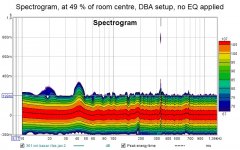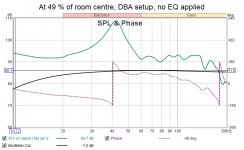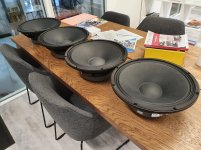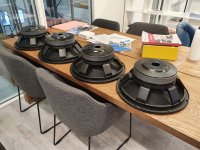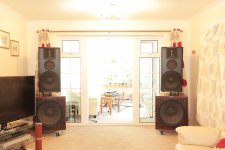Ok, time to start a new build.
This time it will be on the larger side...
Stereo IB's with dual Beyma 21PW1400FE per manifold Beyma Speakers - Beyma 21PW1400Fe 21" subwoofer speaker - Beyma 21PW1400Fe high power 2,800 watt 21" woofer for all bass applications. Beyma 21PW1400Fe and other Beyma 18" speakers here.
Midbass with dual Beyma 15P80FeN in sealed enclosures Beyma Speakers - Beyma 15P80FeN speaker - Beyma 15P80Fe Water Resistant Speaker, 1,600 watt 15" woofer for all mid-bass applications. Beyma 15P80FeN and other Beyma 15" speakers here. Great for indoor or outdoor use.
Midrange with dual Jantzen JA-8008 HMQ http://www.jantzen-audio.com/wp-content/uploads/2013/06/JA-8008-HMQ.pdf
The higher frequencies will be taken care of a Beyma TPL-150B https://www.beyma.com/speakers/Fichas_Tecnicas/beyma-speakers-data-sheet-amt-TPL150B.pdf
IB's are already up and running since a couple of years.
Midbass enclosures will be sealed (not ready yet) around 40L net volume per woofer, 2 per side. Expected to be crossed 80 - 300 Hz.
Midrange enclosures will also be built sealed with a volume of about 15L per box. 1 driver per box. 2 per side. 300 - 2000 Hz.
TPL-150B with open back into sealed stuffed cavity modification from 2000Hz.
It will be a IBWWMTM...? 🙂
This will be an active 4-way system with Minidsp OpenDRC-DA8🙂confused🙂 and Crown XLS amps for the woofers and Firstwatt M2's for the mids and tweeters. Expecting 100dB+ sensitivity.
I'm a total noob when it comes to Minidsp so this will take some time to learn. Done some studies already and it does seem quite easy to get started anyway. Time will tell.
If somebody has a better suggestion than the OpenDRC-DA8 for X-over and DSP duty, please do tell. We have no secrets...
/Z
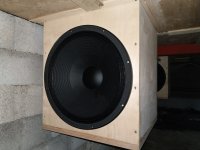
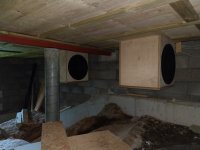
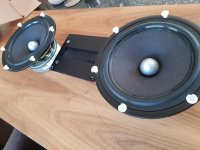
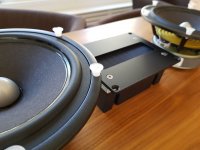
This time it will be on the larger side...
Stereo IB's with dual Beyma 21PW1400FE per manifold Beyma Speakers - Beyma 21PW1400Fe 21" subwoofer speaker - Beyma 21PW1400Fe high power 2,800 watt 21" woofer for all bass applications. Beyma 21PW1400Fe and other Beyma 18" speakers here.
Midbass with dual Beyma 15P80FeN in sealed enclosures Beyma Speakers - Beyma 15P80FeN speaker - Beyma 15P80Fe Water Resistant Speaker, 1,600 watt 15" woofer for all mid-bass applications. Beyma 15P80FeN and other Beyma 15" speakers here. Great for indoor or outdoor use.
Midrange with dual Jantzen JA-8008 HMQ http://www.jantzen-audio.com/wp-content/uploads/2013/06/JA-8008-HMQ.pdf
The higher frequencies will be taken care of a Beyma TPL-150B https://www.beyma.com/speakers/Fichas_Tecnicas/beyma-speakers-data-sheet-amt-TPL150B.pdf
IB's are already up and running since a couple of years.
Midbass enclosures will be sealed (not ready yet) around 40L net volume per woofer, 2 per side. Expected to be crossed 80 - 300 Hz.
Midrange enclosures will also be built sealed with a volume of about 15L per box. 1 driver per box. 2 per side. 300 - 2000 Hz.
TPL-150B with open back into sealed stuffed cavity modification from 2000Hz.
It will be a IBWWMTM...? 🙂
This will be an active 4-way system with Minidsp OpenDRC-DA8🙂confused🙂 and Crown XLS amps for the woofers and Firstwatt M2's for the mids and tweeters. Expecting 100dB+ sensitivity.
I'm a total noob when it comes to Minidsp so this will take some time to learn. Done some studies already and it does seem quite easy to get started anyway. Time will tell.
If somebody has a better suggestion than the OpenDRC-DA8 for X-over and DSP duty, please do tell. We have no secrets...
/Z




Looks pretty fun! Reminds me of this setup a few years back.
Active high dynamics/SPL & high performance loudspeaker system for my living room…!
Active high dynamics/SPL & high performance loudspeaker system for my living room…!
Whoa! That's gonna be loud!
Not sure how far you can push the TL150 Xover but as you know the lower the better for MTM. Doing an MTM with 8" woofers puts a lot of strain on the Tweeter. Might want to entertain small mids or go TM instead? Maybe a quick prototype or separate enclosures for the Tweeter and Mids so you can test topologies?
Not sure how far you can push the TL150 Xover but as you know the lower the better for MTM. Doing an MTM with 8" woofers puts a lot of strain on the Tweeter. Might want to entertain small mids or go TM instead? Maybe a quick prototype or separate enclosures for the Tweeter and Mids so you can test topologies?
"Might want to entertain small mids or go TM instead?"
I have heard the older version of the 8008's in a MTM with a ribbon.
Best midrange I've ever heard...
I have heard the older version of the 8008's in a MTM with a ribbon.
Best midrange I've ever heard...
Cool! I might have bee concerned with the C2C spacing but if it sounds great then perfect!
Well, let's hope. I have not heard this setup yet. 🙂
Several TPL-150 owners favor a crossover above 1,600Hz, which will produce lobing in an MTM configuration with 8" midrange. A few commercial designs use a T-M-W configuration with high efficiency(97db) pro sound 8" midranges and a 15" woofer. I have also seen designs with a pro sound 6" midrange for a 2,000Hz crossover frequency.
Faital 8PR200 gets high reviews. I would use this driver to a good 15" woofer.
B&C 8MDN51 uses a higher Fs to produce higher efficiency
Faital 8PR200 gets high reviews. I would use this driver to a good 15" woofer.
B&C 8MDN51 uses a higher Fs to produce higher efficiency
Attachments
Several TPL-150 owners favor a crossover above 1,600Hz, which will produce lobing in an MTM configuration with 8" midrange. A few commercial designs use a T-M-W configuration with high efficiency(97db) pro sound 8" midranges and a 15" woofer. I have also seen designs with a pro sound 6" midrange for a 2,000Hz crossover frequency.
Faital 8PR200 gets high reviews. I would use this driver to a good 15" woofer.
B&C 8MDN51 uses a higher Fs to produce higher efficiency
Thanks for the input LineSource.
I already have all the drivers and my mind set on this setup so I will just have to see (hear) how much this lobing will affect the end result. Also, in this project I have other priorities that are much higher on the list than off axis response. 😉 If it becomes a major issue, well then I have learned something the hard way (won't be the first time for me). All ideas for improvement are welcome, learning all the time.
I guess you have a rectangular room and that the subs are positioned close to one end wall. Correct?
EQ:ing those subs should be the last thing to do, icing on the cake for one listening position. Before EQ:ing, it would be best to figure out best position for the sofa, to avoid placing it in a typical room mode dip. Dips and SBIR (speaker boundary interference response) cannot be EQ:ed well, while peaks at low frequencies are more manageable with EQ.
What are the dimensions of the room, LxWxH and what type of construction? Drywall all around, concrete or a mix? With the pair of subs at an end wall, your 1st length mode will have it deepest dip (node) and your 2nd length mode its highest peak (anti node) at the room’s acoustical centre. Avoid that place if at all practical for you.
I would place a long piece of tape on the floor right between your subs and starting from physical centre of the room mark it 0, -10 cm, +10 cm and so forth up to +/- 1 m or so from the centre. Then you make a number of REW measurements along the marks. Mark on the tape where you get the very lowest dip for the 1 st mode. It should also be very close to the highest peak of your 2nd length mode. That is your acoustical room center. Now, if you have a room with flimsy drywalls and behind it a room with a stiff and heavy outer wall, you may find that frequency / wave length of the 1st length mode says your listening room is acoustically actually longer than its physical dimensions. Check if your 3 rd length mode has its very deepest dip at the same mark as for the 1st. (It probably hasn’t). Mark it on the tape. Calculate the wave length of the 3rd length mode and mark its next dip with its peak in between. Calculate the wavelength of the 2nd and do the same. Suitable place for the sofa would be where you avoid sitting in a deep dip for any of the first 3 length modes as these cannot be equalized up with good results.
(I placed my subs at both frontwall and backwall. Hooked up in phase I get a huge peak for the 2nd length mode around 40 Hz. Going on REW’s Spectrogram it dies out quickly though with little ringing. Crossover is at 180 Hz which is shown with a deep dip. Good thing is that the 40 Hz peak can be eq:ued down, and with DSP a better change over / phase to the mid bass can be fixed. The increase below 20 Hz comes from the room entering its pressure mode and it ends up at about 101 dB at 10 Hz (if the calibration file of -7,2 dB / 10 Hz for the UMIK is to be trusted. Where in Gothenburg do you live by the way? I live quite nearby Åbytravet.)
EQ:ing those subs should be the last thing to do, icing on the cake for one listening position. Before EQ:ing, it would be best to figure out best position for the sofa, to avoid placing it in a typical room mode dip. Dips and SBIR (speaker boundary interference response) cannot be EQ:ed well, while peaks at low frequencies are more manageable with EQ.
What are the dimensions of the room, LxWxH and what type of construction? Drywall all around, concrete or a mix? With the pair of subs at an end wall, your 1st length mode will have it deepest dip (node) and your 2nd length mode its highest peak (anti node) at the room’s acoustical centre. Avoid that place if at all practical for you.
I would place a long piece of tape on the floor right between your subs and starting from physical centre of the room mark it 0, -10 cm, +10 cm and so forth up to +/- 1 m or so from the centre. Then you make a number of REW measurements along the marks. Mark on the tape where you get the very lowest dip for the 1 st mode. It should also be very close to the highest peak of your 2nd length mode. That is your acoustical room center. Now, if you have a room with flimsy drywalls and behind it a room with a stiff and heavy outer wall, you may find that frequency / wave length of the 1st length mode says your listening room is acoustically actually longer than its physical dimensions. Check if your 3 rd length mode has its very deepest dip at the same mark as for the 1st. (It probably hasn’t). Mark it on the tape. Calculate the wave length of the 3rd length mode and mark its next dip with its peak in between. Calculate the wavelength of the 2nd and do the same. Suitable place for the sofa would be where you avoid sitting in a deep dip for any of the first 3 length modes as these cannot be equalized up with good results.
(I placed my subs at both frontwall and backwall. Hooked up in phase I get a huge peak for the 2nd length mode around 40 Hz. Going on REW’s Spectrogram it dies out quickly though with little ringing. Crossover is at 180 Hz which is shown with a deep dip. Good thing is that the 40 Hz peak can be eq:ued down, and with DSP a better change over / phase to the mid bass can be fixed. The increase below 20 Hz comes from the room entering its pressure mode and it ends up at about 101 dB at 10 Hz (if the calibration file of -7,2 dB / 10 Hz for the UMIK is to be trusted. Where in Gothenburg do you live by the way? I live quite nearby Åbytravet.)
Attachments
Last edited:
I guess you have a rectangular room and that the subs are positioned close to one end wall. Correct?
What are the dimensions of the room, LxWxH and what type of construction?
Where in Gothenburg do you live by the way? I live quite nearby Åbytravet.)
Correctomundo Adhoc, rectangular room with subs next to the wall.
Room is 14,8 m x 5,5 m x 4,25 m
It consists of a living room of 36 sqm (where the sound gear is), open into a dining room of 22 sqm, open into a kichen of 22 sqm. Total open area is 80 sqm. Height in the living room is 4,25 at the highest (irregular ceiling). One wall is 3 meters high (where speakers are) back wall is 4 meters high. So, the volume is quite big.
I have come to the following conclusion so far... I need large speakers! 😛
Your explanation/method sounds interesting! Will try this at a later stage in the project for sure. Thanks for input!
I live just outside of the city, in Gunnilse.
Really like what your're doing ZACC....i need big speakers too, albeit with pinpoint imaging....looks like the same for you.
You mentioned the DRC DA-8. I had one and it worked well.
You mentioned the DRC DA-8. I had one and it worked well.
More measuring today and learning a lot. Hooked up my Minidsp 2X4 HD and applied a first filter from REW to the IB's. Crossing at 100 Hz both up and down just to test and sounds OK so far.
This is really fun! I'm amazed that this technology is so easy to get and the cost is so low.
Measurement at sweetspot with IB's and main speakers.
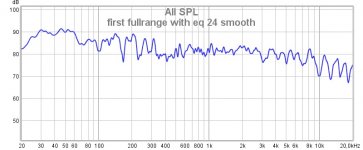
This is really fun! I'm amazed that this technology is so easy to get and the cost is so low.
Measurement at sweetspot with IB's and main speakers.

Well, listening to two sources is likely to be in the position of having the ears not on axys to the relative channel, so it resembles something like having the "off axys response" at your ears.Also, in this project I have other priorities that are much higher on the list than off axis response. 😉
I mean, you have to be responsive of what you hear, and especially if you DIY, you are the main cause. So I wouldn't dismiss lobing, since lobing is the product of the vectors superimposing on each other, but, yes, you're talking about gigantic membranes, so who cares, there are other (big) problems

Hi ZAAC,
My system also uses those same size drivers:
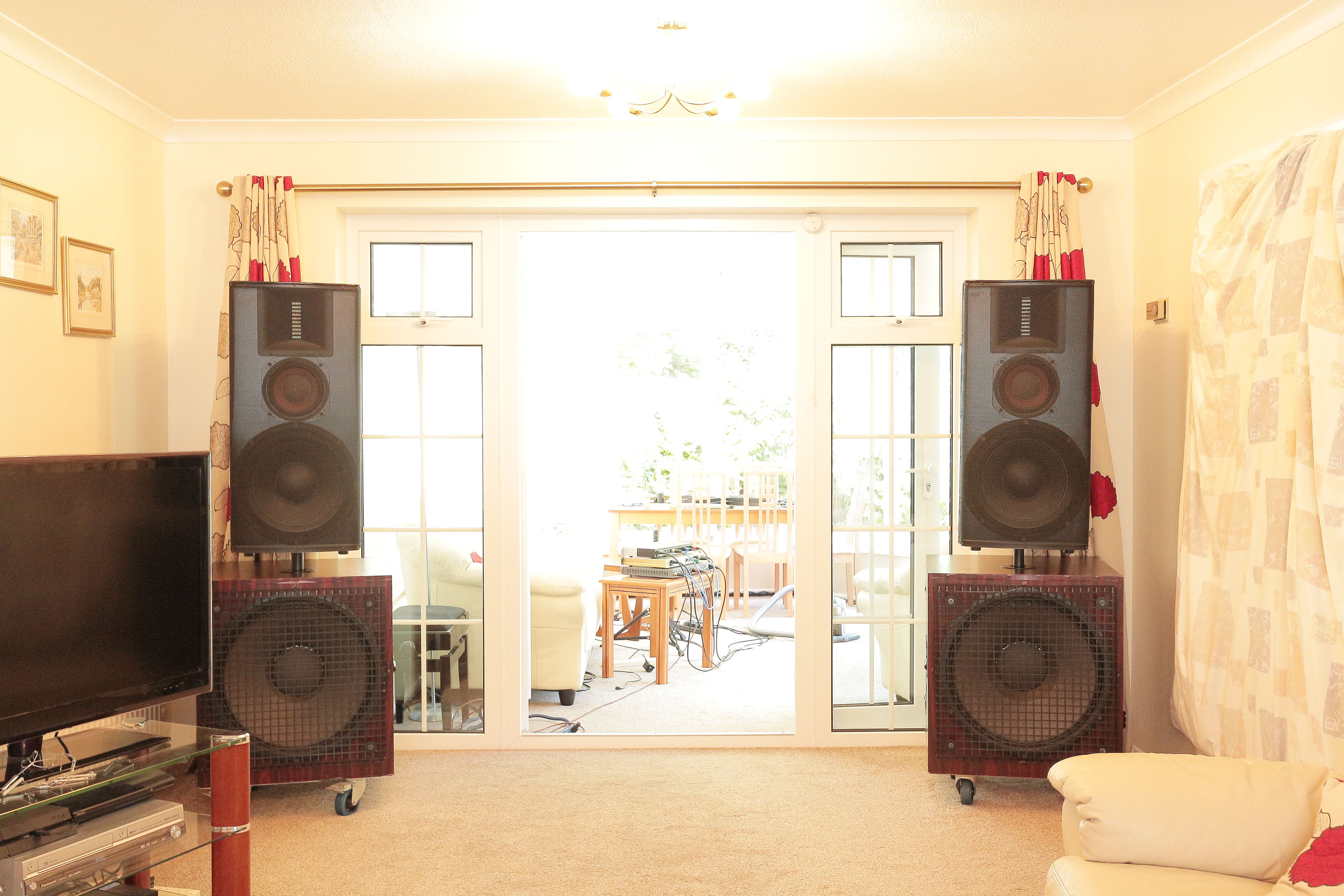
AMT tweeter = Beyma TPL150H
8" midrange = 18Sound 8NMA610
15" woofer = Faital Pro 15XL1400
21" woofer = Precision Devices PD2151 Neo
...however I'm using a stack of FOUR (4x) MiniDSP OpenDRC-DI 2x2 to do the necessary FIR corrections, per driver, because those offer 6144 taps per channel. (So I have altogether 8x channels running with 6144 taps for each individual drive unit.)
Personally, I don't feel that one single OpenDRC-DA8 machine (offering only 1200 taps per channel if shared equally between its 8 channels, or an absolute maximum of 2400 taps allocation per individual channel) will actually have enough FIR taps available for complete correction of the amplitude and phase responses down to the lowest bass / subwoofer ranges, if that's what your target is.
My experiences with drivers of this size, their typical behaviour, and measuring them, has show me than even with 6144 taps it's a struggle to reach 100% accurate FIR impulse correction for the lowest bass. I yearn to have a better FIR hardware solution with even more taps to be honest.
Your mileage may vary, because obviously you're using different specific drivers and cabinet designs to mine, but I'd still recommend looking at an FIR solution with more total taps if you're considering going that route.
https://www.diyaudio.com/forums/attachment.php?attachmentid=808662&stc=1&d=1578923284
My system also uses those same size drivers:
AMT tweeter = Beyma TPL150H
8" midrange = 18Sound 8NMA610
15" woofer = Faital Pro 15XL1400
21" woofer = Precision Devices PD2151 Neo
...however I'm using a stack of FOUR (4x) MiniDSP OpenDRC-DI 2x2 to do the necessary FIR corrections, per driver, because those offer 6144 taps per channel. (So I have altogether 8x channels running with 6144 taps for each individual drive unit.)
Personally, I don't feel that one single OpenDRC-DA8 machine (offering only 1200 taps per channel if shared equally between its 8 channels, or an absolute maximum of 2400 taps allocation per individual channel) will actually have enough FIR taps available for complete correction of the amplitude and phase responses down to the lowest bass / subwoofer ranges, if that's what your target is.
My experiences with drivers of this size, their typical behaviour, and measuring them, has show me than even with 6144 taps it's a struggle to reach 100% accurate FIR impulse correction for the lowest bass. I yearn to have a better FIR hardware solution with even more taps to be honest.
Your mileage may vary, because obviously you're using different specific drivers and cabinet designs to mine, but I'd still recommend looking at an FIR solution with more total taps if you're considering going that route.
https://www.diyaudio.com/forums/attachment.php?attachmentid=808662&stc=1&d=1578923284
Attachments
wow another big drivers lovers 😀 big sound does not come from sissy driver
https://www.diyaudio.com/forums/sol...-active-minidsp-4-amplifer-4.html#post6030415
21" - 12" - 5" - small ribbon, all controlled by 2 of minidsp 2x4HD. plus dual-opposed subwoofer, and finishing 2nd subwoofer set.
my setup is not as big as yours but i'm sure you will get very decent result later. keep us posted
https://www.diyaudio.com/forums/sol...-active-minidsp-4-amplifer-4.html#post6030415
21" - 12" - 5" - small ribbon, all controlled by 2 of minidsp 2x4HD. plus dual-opposed subwoofer, and finishing 2nd subwoofer set.
my setup is not as big as yours but i'm sure you will get very decent result later. keep us posted
Hi ZAAC,
My system also uses those same size drivers:
AMT tweeter = Beyma TPL150H
8" midrange = 18Sound 8NMA610
15" woofer = Faital Pro 15XL1400
21" woofer = Precision Devices PD2151 Neo
...however I'm using a stack of FOUR (4x) MiniDSP OpenDRC-DI 2x2 to do the necessary FIR corrections, per driver, because those offer 6144 taps per channel. (So I have altogether 8x channels running with 6144 taps for each individual drive unit.)
Personally, I don't feel that one single OpenDRC-DA8 machine (offering only 1200 taps per channel if shared equally between its 8 channels, or an absolute maximum of 2400 taps allocation per individual channel) will actually have enough FIR taps available for complete correction of the amplitude and phase responses down to the lowest bass / subwoofer ranges, if that's what your target is.
My experiences with drivers of this size, their typical behaviour, and measuring them, has show me than even with 6144 taps it's a struggle to reach 100% accurate FIR impulse correction for the lowest bass. I yearn to have a better FIR hardware solution with even more taps to be honest.
Your mileage may vary, because obviously you're using different specific drivers and cabinet designs to mine, but I'd still recommend looking at an FIR solution with more total taps if you're considering going that route.
https://www.diyaudio.com/forums/att...al-21-dual-15-dual-8-tpl-150-ibwwmtm-4way-jpg
Great system. I bet it sounds great. Thanks for sharing.
I have just entered the wonderful world of DSP so I have a lot to learn and read up on. Will look into FIR when the time comes for filters. Thanks for input. BTW, would 2 pcs MiniDSP 2 x 4 HD work? How does one hook them up for a 4-way stereo set-up? 1 per side?
/Z
- Home
- Loudspeakers
- Multi-Way
- 4-way with dual 21", dual 15" & dual 8" + TPL-150. An IBWWMTM...


